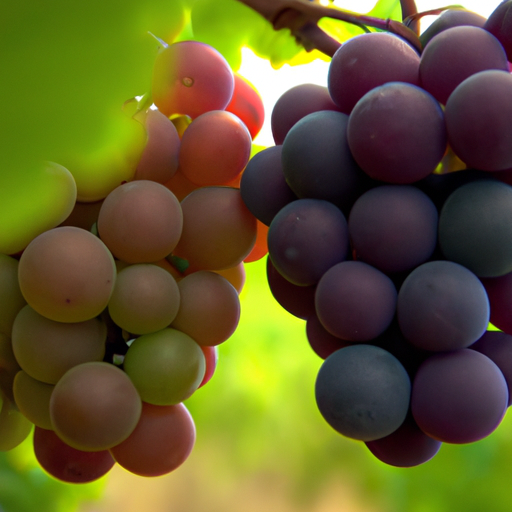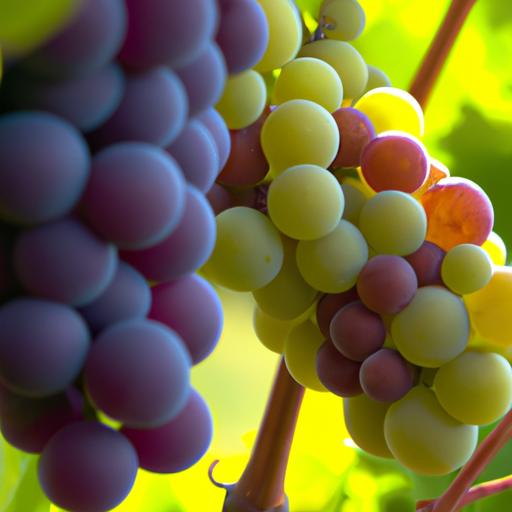
The Science Behind Grape Veraison: Understanding the Color Transformation Process
Understanding Grape Veraison: Does the Color of Grapes Change?
Grape veraison is a crucial stage in the development of grapes, where they undergo a remarkable transformation in color. This process is of great interest to winemakers and grape growers, as it directly affects the quality and characteristics of the final wine. In this article, we will delve into the science behind grape veraison and explore the factors that contribute to the color transformation of grapes.
Veraison is a French term that refers to the onset of ripening in grapes. It is during this stage that the grapes transition from their initial green color to their final hue, which can range from pale yellow to deep purple, depending on the grape variety. This color change is a result of complex biochemical processes occurring within the grape berries.
One of the key factors influencing grape veraison is the accumulation of pigments in the grape skins. These pigments, known as anthocyanins, are responsible for the red, purple, and blue colors observed in many grape varieties. During veraison, the concentration of anthocyanins increases, leading to a visible change in color.
The accumulation of anthocyanins is influenced by various environmental factors, such as temperature, sunlight exposure, and vineyard management practices. Cooler temperatures and shorter daylight hours can delay veraison, while warmer temperatures and longer days can accelerate the process. Additionally, vineyard practices such as leaf removal and canopy management can affect the amount of sunlight reaching the grape clusters, thereby influencing the color development.
Another important factor in grape veraison is the breakdown of chlorophyll, the green pigment responsible for photosynthesis in plants. As the grapes ripen, chlorophyll is broken down, revealing the underlying pigments and allowing the color transformation to occur. This breakdown is triggered by changes in hormone levels within the grape berries, which signal the transition from growth to ripening.
Furthermore, the acidity of the grapes also plays a role in the color transformation during veraison. As the grapes ripen, their acidity decreases, which can affect the stability and intensity of the pigments. Lower acidity levels can result in a more vibrant and intense color, while higher acidity levels may lead to a lighter and less pronounced hue.
It is worth noting that the color transformation during veraison is not uniform across all grape varieties. Some grapes, such as white varieties, do not undergo a significant color change and remain relatively unchanged throughout the ripening process. However, even in these cases, other biochemical changes occur, such as the accumulation of sugars and the development of flavors.
In conclusion, grape veraison is a fascinating stage in the life cycle of grapes, where they undergo a remarkable color transformation. The accumulation of anthocyanins, breakdown of chlorophyll, and changes in acidity all contribute to this process. Understanding the science behind grape veraison is essential for winemakers and grape growers, as it allows them to optimize vineyard practices and produce wines with desired color and flavor profiles. So, the next time you enjoy a glass of wine, take a moment to appreciate the intricate journey that the grapes have undergone to reach your glass.
Factors Influencing Grape Veraison and Color Change in Grapes

Understanding Grape Veraison: Does the Color of Grapes Change?
Grape veraison is a crucial stage in the development of grapes, where they transition from hard, green berries to plump, juicy fruits. This process is marked by a significant change in color, as the grapes transform from green to red, purple, or even black, depending on the variety. But what factors influence this color change, and why does it occur?
One of the primary factors influencing grape veraison and color change is the variety of grape itself. Different grape varieties have different natural pigments, known as anthocyanins, which give them their distinct colors. For example, red grapes contain high levels of anthocyanins, resulting in their vibrant red or purple hues. On the other hand, white grapes have lower levels of anthocyanins, leading to their pale green or yellow coloration.
Another factor that affects grape veraison and color change is sunlight exposure. Sunlight plays a crucial role in the development of anthocyanins in grapes. When grapes are exposed to sunlight, the ultraviolet (UV) rays stimulate the production of anthocyanins, leading to a more intense coloration. This is why grapes that receive ample sunlight tend to have deeper, richer colors compared to those grown in shaded areas.
Temperature also plays a significant role in grape veraison and color change. Warmer temperatures promote the synthesis of anthocyanins, resulting in a faster and more pronounced color change. Conversely, cooler temperatures can delay the veraison process and lead to lighter-colored grapes. This is why grapes grown in cooler regions often have a lighter color compared to those grown in warmer climates.
Furthermore, the timing of grape veraison can vary depending on the grape variety and the region in which it is grown. Generally, veraison occurs in late summer or early autumn, signaling the onset of the ripening process. However, the exact timing can be influenced by factors such as climate, soil conditions, and vineyard management practices. For example, grapes grown in cooler regions may experience veraison later in the season compared to those grown in warmer areas.
It is important to note that not all grape varieties undergo a color change during veraison. Some grape varieties, such as Muscat grapes, remain green even when fully ripe. This is due to the absence of anthocyanins in their skin, resulting in a lack of color change. However, these grapes can still develop other signs of ripeness, such as increased sugar content and flavor development.
In conclusion, grape veraison is a critical stage in the development of grapes, marked by a significant color change. Factors such as grape variety, sunlight exposure, temperature, and timing all influence the color change during veraison. Understanding these factors can help grape growers and winemakers optimize their vineyard management practices to achieve desired color and flavor profiles in their grapes. So, the next time you enjoy a glass of red or white wine, take a moment to appreciate the intricate process of grape veraison that contributes to its vibrant color and exquisite taste.
The Significance of Grape Veraison in Wine Production: Impact on Flavor and Quality
Understanding Grape Veraison: Does the Color of Grapes Change?
Grape veraison is a crucial stage in the life cycle of grapes, particularly for winemakers. It is during this period that the grapes undergo significant changes in color, texture, and flavor, ultimately determining the quality and characteristics of the resulting wine. In this article, we will delve into the significance of grape veraison in wine production and explore its impact on flavor and quality.
Veraison is a French term that refers to the onset of ripening in grapes. It is a critical phase that typically occurs in late summer or early autumn, depending on the grape variety and the climate of the region. During this stage, the grapes transition from hard, green berries to soft, plump fruits, and their color begins to change.
One of the most noticeable changes during veraison is the alteration in grape color. Green grapes gradually transform into shades of red, purple, or black, depending on the grape variety. This color change is primarily due to the accumulation of pigments called anthocyanins in the grape skins. As the grapes ripen, the concentration of anthocyanins increases, resulting in the vibrant hues that we associate with ripe grapes.
The color change during veraison is not merely an aesthetic transformation; it also has significant implications for wine production. The color of the grape skins directly affects the color of the resulting wine. Red grapes, for instance, produce red wines, while white or green grapes are used to make white wines. The intensity of the color can also vary, ranging from pale pink to deep purple, depending on the grape variety and the duration of skin contact during fermentation.
In addition to color, veraison also impacts the flavor profile of the grapes and, consequently, the resulting wine. As the grapes ripen, their sugar content increases, while acidity levels decrease. This shift in sugar and acid balance affects the taste of the grapes, making them sweeter and less tart. The flavors become more pronounced and complex, with hints of berry, plum, or even floral notes, depending on the grape variety.
Furthermore, veraison is a crucial stage for winemakers to determine the optimal time for harvest. The timing of harvest is critical as it directly affects the balance of sugar, acidity, and flavor in the grapes. Harvesting too early may result in underripe grapes with high acidity and green flavors, while delaying the harvest may lead to overripe grapes with excessive sugar and low acidity. Therefore, winemakers closely monitor the progress of veraison to ensure they harvest the grapes at the peak of ripeness, capturing the desired flavors and characteristics.
In conclusion, grape veraison is a significant stage in wine production, impacting both the flavor and quality of the resulting wine. The color change during veraison is not merely a visual transformation but also determines the color of the wine. Additionally, the ripening process affects the sugar and acid balance, resulting in sweeter and more complex flavors. Winemakers carefully monitor veraison to determine the optimal time for harvest, ensuring the grapes are picked at their peak ripeness. Understanding grape veraison is essential for winemakers and wine enthusiasts alike, as it provides insights into the fascinating journey from grape to glass.






